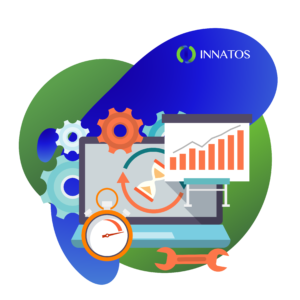How to improve ERP functionalities for remote work
How to improve ERP functionalities for remote work. Telecommuting has been an essential part of keeping teams up and running during these difficult months with COVID-19. Many of the technologies that have been used will remain with all of us, thanks to the usefulness they offer us to carry out certain work or commercial activities.
The absence of remote work programs can contribute to communication disruptions, decreased productivity, difficulties with timely reporting and financial closings, and increased cybersecurity risks, to name a few.
In this aspect, it’s essential to review and adapt certain functionalities of ERP systems, to ensure that workers can perform any type of management or operation required without incurring deficits or shortfalls in daily needs and achieving the same productivity as if they were at their regular workstations. These adaptations can also improve the work of personnel who need mobility due to their type of activity.
These are some of the keys to help improve the functionality of your ERP solution while working across a remote ecosystem:
-
Empowering remote work and productivity.
 Adapting the right remote work technologies, processes and training and making them work properly has been a very important priority for most companies during these months and will still continue perhaps until the end of the year. Remote work is a must-have tool for maintaining employee productivity and continuity if mobility is reduced due to unavoidable circumstances.
Adapting the right remote work technologies, processes and training and making them work properly has been a very important priority for most companies during these months and will still continue perhaps until the end of the year. Remote work is a must-have tool for maintaining employee productivity and continuity if mobility is reduced due to unavoidable circumstances.
To help preserve productivity, companies must implement tools and policies that allow employees who continue to telecommute to operate as if they were at their regular jobs.
Organizations will also need to create collaborative workflows within their ERP system and then train employees on new processes and security protocols.
It’s important to quickly provide employees with remote work guidelines on their laptops and smartphones, as well as secure home networks to protect sensitive information and data, such as vendor account numbers.
-
Ongoing remote training, how to improve ERP functionalities
Remote work can be a very useful tool not only for the current situation but for the future, as a consequence the technical resources and communications of all employees must be prepared, to take full advantage of all the digital features offered by the ERP in business management and training in new applications is constant.
-
Ensure access to ERP systems
It’s essential that essential personnel can securely access ERP systems via VPN or via the web, and that configurations for remote IT support are up-to-date and tested.
Cloud-based ERP solutions offer an advantage over on-premises systems because they are designed to be managed remotely; they also offer immediate scalability and flexibility for fluctuations in business needs.
-
Automate manual business practices, how to improve ERP functionalities
 Inside and outside of ERP, organizations will need to automate manual business processes and workflows to create operational efficiencies in a remote work environment, not only during COVID-19, but they should stay to face the future with greater assurance.
Inside and outside of ERP, organizations will need to automate manual business processes and workflows to create operational efficiencies in a remote work environment, not only during COVID-19, but they should stay to face the future with greater assurance.
They should, for example, consider automating approval workflows such as order and invoice processing. Similarly, the practice of using manual spreadsheets for reporting and forecasting will need to be replaced with something automated and centralized.
Organizations may also consider adopting technologies such as artificial intelligence to help automate warehouse functions such as receiving, returns and EDI purchase order processing. For companies with warehouse operations, automated picking, packing and shipping can help stabilize business activities in times of crisis.
-
Anticipate changes in accounting and financial records.
The devastating economic impact of COVID-19 will likely result in new accounting rules. ERPs must therefore be prepared to reconfigure their systems, and therefore new or unusual items must be exposed in balance sheets and financial presentations.
You must also be prepared to track and report COVID-19 costs, create new ledgers and projects, and possibly redesign your chart of accounts.
-
Digitize AP processing, how to improve ERP functionalities
Organizations that have not automated their invoice processing functions are likely to struggle with manually processing invoices, transmitting physical checks, and depositing accounts receivable.
For many, the first steps will be to develop contingency plans and implement processes and technologies to make electronic payments and ensure maximum security, especially in the home environments of the people managing these processes.
-
Enable AR processes
In national emergencies, it can be difficult to contact entities that have not paid their invoices or deposit incoming payments. To help stabilize cash flow, accounts receivable (AR) modules can be added to ERP systems to help organizations send dunning notices, determine optimal payment terms and track payments.
On the other hand, focusing on improving customer communications, offering incentives for early payment, enabling payment holds and discounts can produce better accounting and collection results in exceptional and complicated situations.
-
Leverage reports and dashboards, how to improve ERP functionalities
Many employees are dispersed and virtual, and that can disrupt reporting and data analysis processes and workflows. Dashboards and workflows built into ERP solutions can help companies manage remote reporting. They can also be customized to help teams manage unexpected costs, new accounting items and financial closings.
Remote work: how to take advantage of a management system
After the crisis situation caused by COVID-19, companies have adapted their work activity to the new business needs and security measures. Teleworking was introduced in companies of all types and in a large part of the workforce. This forced companies to consider new ways of providing business continuity, one of which was undoubtedly the implementation of online tools and process management systems.
Now that normality is gradually returning, several organizations have evaluated the possibility of maintaining this remote work modality. And in this scenario, there is also an opportunity to increase investment in technology that allows for the proper management of projects, data, clients and work teams.
-
Looking to the future, how to improve ERP functionalities
This situation has been a challenge for many companies. All departments have had to adapt quickly, and the Human Resources department has been no exception. Its general function has been to maintain fluid communication with employees. This allowed it to be in charge of keeping reports up to date, dealing with requests or, in other areas, controlling administrative activities.
It’s true that implementing this model is not an easy task since it requires reorganizing the workforce to some extent. This is establishing suitable workplaces, providing access to tools that allow maintaining optimal levels of service to achieve the same or higher productivity.
-
Working in the cloud, how to improve ERP functionalities
Now, one of the concerns of organizations is how to ensure a secure and reliable digital environment for both employees and customers. On the other hand, the flexibility and availability of data ensures that each area of the company completes its tasks in a timely manner. Cloud-based systems play a decisive role in this respect.
This is the case of management systems, which allow information to be hosted and modified from an integrated platform and on any device connected to the Internet.
How does the telework context apply to the Human Resources department?
For those companies that think of teleworking as an option to face-to-face activity, a Human Resources Management system provides the necessary tools for the administration and planning of work. It adapts to the needs of the organization as it’s a customizable platform where Human Resources can manage each module according to the area, its projects and requests.
It prioritizes communication, essential in this modality of work. A characteristic of cloud-based management systems is their mobility capability. With it, staff can stay connected, both with their colleagues and with the information they manage on a daily basis. Specifically, management suites offer the possibility of access from a smartphone, tablet or computer.
This is possible with features such as a mobile app for each user. With it you can consult from payroll and timesheets to expense reports. Or the planning or workflow modules which facilitate communication between employees and managers as well as delegating activities between employees. And all this is visible through a dashboard where performance metrics are displayed for better decision making.
Conclusions
Companies will be better positioned and will emerge stronger from COVID-19 if they are able to flexibly manage the operational impacts of the pandemic. Automating processes and increasing efficiency should be a priority for any company.
A customized ERP, synchronized with all areas of an organization, can improve resilience during this ongoing global emergency and prepare for a future in which today’s operational anomalies become tomorrow’s guarantees of continuity.









Leave a Reply
Want to join the discussion?Feel free to contribute!